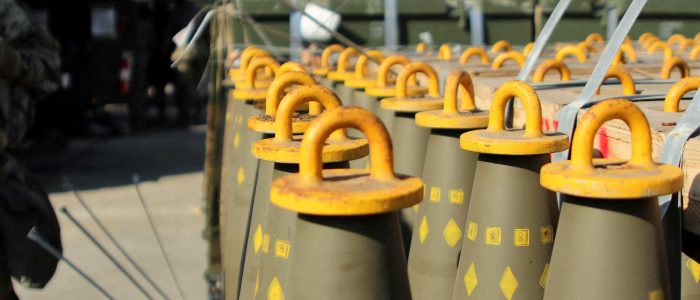Amidst the shadow of a destructive and protracted conflict, there is growing controversy surrounding the use of cluster weapons in the Russo-Ukraine War. This has raised concerns among the global community. With the conflict prolonged, the impact on civilians and essential infrastructure have worsened, leading to discussions that go beyond national boundaries. The distressing visuals of lives displaced and ruined cities compel us to face the harsh truth about cluster munitions in contemporary warfare.
Cluster bombs are weapon devices that contain smaller projectiles or submunitions. These rockets or artillery shells typically detonate in mid-air or upon hitting a target dispersing the submunition in an area of up to four football fields. The resulting shrapnel can cause damage to buildings and harm individuals within range. The clusters of submunitions raise concerns due to their indiscriminate effects and unexploded remnants. The 2008 Convention on Cluster Weapons/Munitions (CCW or CCM) (effective May 2008) prohibits the use, transfer, production, and stockpiling of these weapons. It sets out measures for victims, risk reduction education, and stockpile destruction. Non-signatory states have shown commitment to building more accurate bombs with minimum to zero unexploded weapons/remnants.
Besides, cluster munitions in populated areas invariably violate International Humanitarian Law (IHL) on the use of weapons that cannot discriminate between civilians and combatants. Numerous human rights organisations, e.g., Human Rights Watch (HRW), Ban Cluster Munition Coalition, Humanity and Inclusion, and International Committee of the Red Cross (ICRC), and many governments have voiced their criticism regarding the use of munitions in the Russo-Ukraine conflict.
Strengthening international norms and encouraging adherence to the CCW in armed conflicts should be encouraged to deal with future humanitarian crises effectively.
Nevertheless, cluster bombs might be a choice for Ukraine’s counterattack against Russian troops due to their long-range striking capability and ability to cover a wide area. Despite objections from human rights organisations, Russia and the United States (US) key allies, the Biden Administration has declared its intention to provide these weapons to Ukraine. The US plans to supply cluster bombs from its arsenal until Ukraine’s shortage of conventional artillery shells is resolved. These shells are apparently crucial in the warfare in eastern and southern Ukraine. With Ukraine depleting its artillery shell stockpile rapidly, the use of cluster bombs could potentially offer Ukrainian forces an advantage in dislodging Russian troops from their trenches and strongholds spanning 600+ miles along the front line. However, a country as influential as the US must not proliferate this kind of weapon.
Mr Biden’s national security adviser, Jake Sullivan, justified the decision to provide cluster weapons to Ukraine by emphasising that the country would be using these munitions within its borders rather than in a foreign nation. However, it is essential to acknowledge the risks involved. The use of cluster munitions by both Russian and Ukrainian forces has resulted in numerous civilian casualties and severe injuries, as reported by HRW.
According to the HRW, since Russia invaded Ukraine on February 24, 2022, Russian armed forces have used at least six types of cluster munitions in attacks that have caused hundreds of civilian casualties and damaged civilian objects, including homes, hospitals, and schools. At least 10 of Ukraine’s 24 regions (oblasts or provinces) have been struck by cluster munitions, including Chernihivska, Dnipropetrovska, Donetska, Kharkivska, Khersonska, Luhanska, Mykolaivska, Odesaska, Zaporizka and Sumska. In 2022, while Russia occupied Izyum, there were rocket attacks that tragically resulted in the loss of at least eight innocent civilians’ lives and caused injuries to 15 others. In Mykolaiv, Russian forces launched cluster munition rockets into populated areas, killing and injuring civilians and damaging homes, businesses, and civilian vehicles. The Russian government has not denied using cluster munitions in Ukraine.
Ukrainian forces have also used cluster munitions provided by the US. Media reports indicate that the Ukrainian forces used cluster munitions in Husarivka in Kharkiv oblast on 6 or 7 March 2023, when Russian troops occupied the village. The Ukrainian government has also not denied the use of such munitions and stated that the Armed Forces of Ukraine “strictly adhere to the norms of international humanitarian law.”
Thirty-six countries have condemned the cluster munition attacks in Ukraine, as have the European Union (EU), Office of the United Nations High Commissioner for Human Rights (OHCHR), and NATO’s Secretary-General. Many human rights organisations emphasised that the world should strongly urge Russia and Ukraine to cease the use of cluster munitions and encourage them to become parties to the CCW. Global leaders must take advantage of every opportunity to denounce the utilisation of cluster munitions in Ukraine, including through joint statements and resolutions. Additionally, all states must commit themselves to not providing any assistance to Russia or Ukraine in activities prohibited under the convention, such as the use and transfer of cluster munitions. Lastly, all nations should be called to join the CCW without any delays. Strengthening international norms and encouraging adherence to the CCW in armed conflicts should be encouraged to deal with future humanitarian crises effectively.
